Golf in the Valley of the Sun
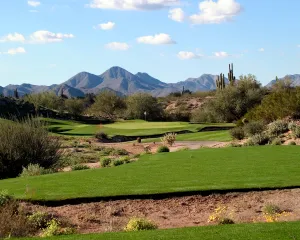
According to the Robb Report, Phoenix-Scottsdale, Arizona, is “America’s Best Place to Live for Golf.” It’s not bad for a visit, either. In fact, I don’t think there’s any better place for a fall or winter golf vacation than the Valley of the Sun.
I’ve had the pleasure of visiting Phoenix-Scottsdale in November for two years in a row. Temperatures ranged from 61 to 87 degrees. In winter, it’s in the mid- to high 60s, perfect golf weather. One small downside of November is that many courses overseed with rye grass in September or October, when the Bermuda grass goes
dormant. It’s brilliant green and lush in November, but also tender, so cart-path-only rules apply. If you’re trying to play 36 holes a day (With 200 course to choose from, what red-blooded golfer wouldn’t?), it takes some stamina.
Speaking of stamina, the hardest thing about golf trips is dragging clubs around airports and rental car lots. This trip, because of tightly scheduled flights and other considerations, there was a chance our clubs would not arrive at Phoenix’s Sky Harbor International Airport when we did. It’s happened before. I’m sure our clubs are still laughing about the time they spent a week in Costa Rica without us. Our first tee time in Scottsdale was 90 minutes after our flight arrived, so there was no room for delay. We also knew our hard-sided travel cases would not fit in the rental car unless we upgraded to a larger vehicle. To avoid any hassles, we asked Sports Express to handle transporting our clubs. Now we’re forever spoiled. More about that later; let’s get to the golf.
Golf courses in the Phoenix-Scottsdale have been multiplying like those ubiquitous desert hares for the past 30 years, and there doesn’t seem to be a letup in either supply or demand. Most are target-style courses with parkland courses, and variations on both themes.
My personal favorites are the courses on Native American land because there are usually no houses on the fairways, just sweeping views of the Sonoran Desert and the surrounding mountain ridges. We-Ko-Pa, a Scott Miller design on the 40-square-mile Fort McDowell Yavapai Nation, leads the pack. Two

days after it opened in 2001, Sports Illustrated called it one of the ten best new courses in the world. We-Ko-Pa is the Yavapai pronunciation for Four Peaks Mountain, a 7,000-foot-high range visible from many holes. The course is not so much carved through the desert as it is integrated into it, with many shots over and around gullies and native vegetation. I have a love-hate relationship with the eighth hole, a double-dogleg par 5 ranked most difficult. An arroyo runs alongside the narrow second landing area, and then crosses the fairway to sprawl in front of and alongside the green. It’s difficult to avoid hitting off its hardpan surface at least once.

The Gila River Indian Community is home to the Sheraton Wild Horse Pass Resort & Spa, a 500-room Native American-themed resort with a waterway flowing through it that can be used to go to the golf club, casino or spa via boat. Gary Panks designed the Whirlwind Golf Club’s Cattail and Devil’s Claw courses, both of which have hole names and symbols reflecting the animals, customs and legends of the tribe. Cattail trails through canyons and around three lakes, while Devil’s Claw follows the rises and falls of higher ground. Late in the day, drumbeats from the resort’s tribal shows echo across the fairways.
Talking Stick Golf Club, named for the carved branch used by the tribe as a calendar of important events, is located in the Salt River Pima-Maricopa Indian Community. Providing a break from target-style desert golf are two diverse courses by architects Ben Crenshaw and Bill Coore. The North Course is a windswept links layout with wide, treeless fairways and deep bunkers. The South Course is parkland style, with native trees, water and deep, fingered bunkers.
After seeing it on television during the FBR Open, everyone wants to play the Tournament Players Club of Scottsdale. There are two layouts here, but the desert terrain. The mounding for spectators is obvious, and the six water holes don’t seem to fit the arid setting. But it is a thrill to play it once, especially the approach to the famous island green of the fifteenth hole.
Another must-play on your first trip are Troon North’s Monument and Pinnacle courses at the Four Seasons Resort Scottsdale, which are consistently ranked one and two among the state’s daily fee courses. Tom Weiskopf

designed both, with Jay Morrish collaborating on the Monument. Homes border both courses—but the Pinnacle has a better buffer of foliage. Both are classic target golf, with blind shots and carries over washes and desert foliage. A granite spire in the dogleg of the third hole gives the Monument course its name. The Pinnacle, studded with boulders and deep sand bunkers, gets its name from Pinnacle Peak, the backdrop of the finishing hole. After 36 holes here, a visit to the spa is in order. The signature golf ball massage, a combination of stretching and kneading with heated golf balls, may sound like a gimmick. Believe me, it is not.

The Raptor Course at Grayhawk Golf Club has been ranked among the nation’s top ten public courses by Golf Magazine, and the accolade is deserved. Tom Fazio’s creation is a minefield of 70 bunkers. That’s 22 more than its companion track, the Talon, which is the work of Gary Panks and David Graham. The Talon’s fairways are wider, but its greens are more undulating. The Talon’s showpiece hole is an island par-3 called Devil’s Drink.
Beginning at the upper end of a gorge, Sun Ridge Canyon drops 300 feet to the valley floor and returns, with great views along the way and several memorable holes on the
ascending back nine. The thirteenth hole has a pretty waterfall beside the second landing area. Architect Keith Foster delivers strong par 3s throughout, including the signature seventeenth hole, a 209-yard carry over a gulch and big bunker to a shallow green.
Scott Miller worked many dramatic elevation changes into the Eagle Mountain Golf Club, an interesting mix of box canyons, rolling hills, and arroyos. Most tee boxes are ringed by desert foliage, which gives the course a natural feel. The finishing hole is not difficult, but leaves a lasting impression. The par-4 tees off from the highest point on the course, dropping to a wide fairway with a string of bunkers and a lake reaching to the green along the right side. Mountains form the jagged skyline.
The Robert Trent Jones, Jr. design at Las Sendas Golf Club in Mesa is a good course to play on arrival or departure, because it is 40 minutes from Phoenix’s Sky Harbor International Airport. The valley where it’s located, surrounded by the Spirit and Red Mountains, was once the ranch of 1930s Western movie star Tom Mix. With a slope of 149, the course is a gauntlet of scrub brush and deep bunkers, serving notice that desert golf is not for sissies.
Scott Miller carved more than 300 bunkers into the three nines at Kierland Golf Club at the Westin Kierland Resort & Spa. The route
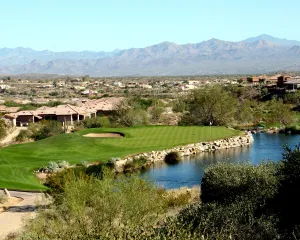
the Westin Kierland Resort & Spa. The route changes elevation frequently, especially on the most dramatic of the three nines, the Acacia. The Acacia, Mesquite and Ironwood nines are named for indigenous trees, a nod to the club’s environmental efforts. It’s one of the few Arizona clubs recognized by Audubon International’s Cooperative Sanctuary Program. If you play here on one of those infamous 115-degree summer days, you’ll be grateful for the misters in the golf carts, which drop the temperature by as much as 50 degrees. The 732-room resort is a showcase for hundreds of years of Arizona history, thanks to the efforts of state historian Marshall Trimble.
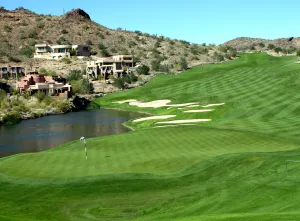
One of my favorite resorts for all-around comfort and indulgence (and decent resort golf) is The Phoenician, a five-star, 250-acre enclave with Allan Houser life-sized bronze sculptures of Native Americans throughout the grounds. The swimming pool complex is one of the best I’ve seen. Three very different nines make up the golf complement. The Oasis is a traditional Florida-style course with palm trees, colorful plantings and water on seven holes. The Canyon, located at the base of Camelback Mountain, has four water challenges, including back-to-back par 3s across water. Tightly bordered by cacti and
brush, the Desert climbs the side of the mountain for tee elevations of 200 feet on two fine par 3s.
In 2005, Travel & Leisure Golf named The Boulders Resort & Golden Door Spa the number one golf resort in the Southwest and number two in the U.S. We found it extraordinary in every respect, from the wow factor of the 12-million-year-old rock formations, to the comfortable casitas, to the sumptuous dining and attentive staff. We played one round with the golf club’s Donald Crawley, a PGA Teacher of the Year, who greatly improved my game with a couple of seemingly minor adjustments. The North and South courses are beautiful, memorable Jay Morrish designs. It’s a must to play both. The South gets the edge for drama because the namesake boulders are in-your-face close on many holes. For instance, the elevated back tee of the seventh hole is dwarfed by “Rosie’s Rock” (named for the resort founder’s wife), which resembles an enormous golf ball perched on the tee beside you.
The Boulders, like most of the other desert courses we played, is a haven for the indigenous hares, birds, coyotes and other wildlife. The balance of nature is apparent here, with coyotes grown fat from dining on the hares that thrive on the lush fairways. The “coyote rule” is a reminder of the species close kinship to dogs. Occasionally a coyote will be unable to resist a rolling ball. If he steals it, you can replay the shot without penalty.
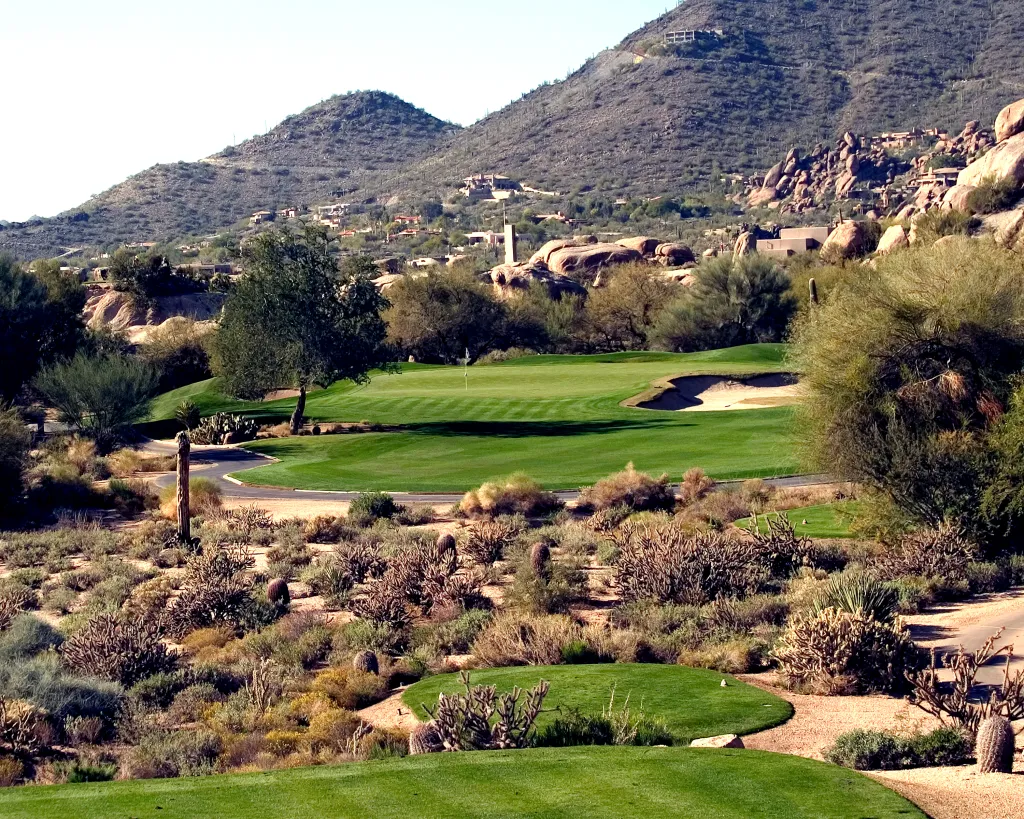
I would like to go on and on about the resorts, restaurants and spas that comprise apres’ golf in the Valley of the Sun, but I won’t. Instead, I’ll tell you about sending clubs (or skis, surfboards, luggage, etc.) with Sports Express.
Sports Express, LLC, was founded in 1999 to provide an alternative way to transport sports equipment and gear. Over the years the company has honed the service, partnering with Fed-X, UPS, airlines, resorts and travel companies. Among those partners is Perry Golf, one of the leading purveyors of golf trips to Europe and exotic locations. When I contacted Sports Express, I was sorry we didn’t have a sterner test of the service than West Virginia to Arizona, perhaps South Africa? But this was a good beginning. Our clubs were picked up on the doorstep of our remote, mountaintop home. They were waiting at Las Sendas Golf Club when we arrived from the airport. When we played our last round at We-Ko-Pa, we left them in the pro shop. Two days later, they were back on our doorstep.
Yes, I could have sent them myself via Fed-X or UPS, but then the arrangements and tracking onus would have been on me. On vacation, busy CEOs (alas, I am not one) want to minimize anything that causes them angst or puts them on a phone or computer. That’s the appeal of Sports Express–one-stop arrangements and total accountability. If your clubs don’t reach South Africa when you do, you make one phone call and then go on safari, knowing it’ll all be worked out.
Services such as Sports Express have arisen from post-9-11 security restrictions, which no one decries, but are a burden nonetheless. On countless occasions we have been delayed while TSA officials pulled out all the contents of our golf bags, then left us to repack and dash to the gate before our flight boarded. Several times our clubs have been put on later flights because of weight restrictions. Once, arriving early in the morning in Scotland, we found that baggage handlers dragged one set of clubs in a soft-sided case across the tarmac, destroying clubs and balls–on the eve of a golf outing. We had to buy clubs on the spot and eal with the airline after we got home. Returning from the Caribbean, going through customs and immigration in San Juan or Miami involves moving clubs, luggage and carry-ons a considerable distance. Shipping with Sports Express eliminates all of these problems.
The service isn’t cheap, but peace of mind often isn’t. From West Virginia to Arizona and back was about $200 per bag. Go to www.SportsExpress.com and click on QuickQuote to get prices for your next trip. Or call 800-357-4174 (970-247-3048 in Colorado) for details. Sports Express LLC is located at 72 Suttle Street, Suite E, Durango, Colorado 81303.
For more information on Scottsdale, visit www.scottsdale cvb.com, which has a 48-page golf guide online.
Tags:
About Dale
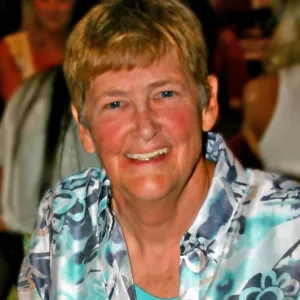
In the course of her life, she has exercised racehorses at New York's Belmont Park, shown jumping horses on the A Circuit, driven a race car with the late Paul Newman, and played the world's most famous golf courses. She is a former private pilot and an avid scuba diver. Read More...

In the course of her life, she has exercised racehorses at New York's Belmont Park, shown jumping horses on the A Circuit, driven a race car with the late Paul Newman, and played the world's most famous golf courses. She is a former private pilot and an avid scuba diver. Read More...
